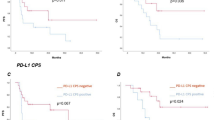Abstract
Objective
to develop an intraperitoneal transplantation model of human ovarian carcinoma SKOV3/CDDP cell in severe combined immunodeficiency (SCID) mouse and to study its biologic characteristics.
Methods
Sixteen qualified C.B17/SCID mouse were divided into two groups randomly. Human ovarian carcinoma SKOV3 or SKOV3/CDDP cells were injected intraperitoneally into the SCID mouse at the amount of 1×107 cells (0.5 mL) per mouse. The behaviors of mice, tumor growth and morphology were analyzed. The expression of cancer antigen 125 (CA 125), GST-π and Topo-II were examined by immunohistochemical method.
Results
In this experimental study, transplanted tumors are formed in 100% SCID mice in the two groups. The morphology, growth pattern and CA125 secretion of SKOV3/CDDP group were as same as those of SKOV3 group. It shows that the tumors of the two groups kept the characteristics of ovaries serosity papillary adenocarcinoma. Compared with SKOV3 group, the expression of GST-π and Topo-II gene in SKOV3/CDDP group were significantly higher (P<0.05).
Conclusion
An intraperitoneal transplantation model of human ovarian carcinoma SKOV3/CDDP in SCID mice has been developed successfully. It may be an ideal animal model for biotherapy research of ovarian carcinoma as it can simulate the biological behavior of peritoneal metastasis of human ovarian carcinoma and the drug tolerance is maintained.
Similar content being viewed by others
References
Yin DM, Jiang WG, Li HX. The research advancement of drug resistance gene in ovarian cancer[J]. Chin J Gin Obstet Gynecol 2004; 5: 314–5.
Barbara M, Paternic A, Siringo S, et al. Potential of the SCID mouse as a host for human tumors[J]. Cancer Metast Rev 1995; 10: 193–200.
Holford J, Beale PJ, Boxall FE, et al. Mechanisms of drug resistance to the platinum complex ZD0473 in ovrian cancer cell lines[J]. Eur J Cancer 2000; 36: 1984–90.
Weber G, shen Df, Li W, et al. Signal transduction and biochemical argeting of ovarian carcinoma[J]. Eur J Gynaecol Oncol 2000; 21: 231.
Zhang YH, Zhang ZhP, Zhao ZQ. Research on the inhibition of the growth of grafted tumor on SCID mice after immune reconstitution[J]. Immunol J 2002; 18: 430–6.
Silver DF, Hempling RE, Piver MS, et al. Effects of IL-12 on human ovarian tumors engrafted into SCID mice[J]. Gynecol Oncol 1999; 72: 154–60.
Schumacher U, Adam E, Horny HP, et al. transplantation of a human ovarian cystadenocarcinoma into severe combined immunodeficiency (SCID) mice-formation of metastases without significant alteration of the tumor cell phenotype[J]. Int J Exp Path 1996; 77: 219–27.
Cui H, Li Y, tong ChT, et al. The study of reconstitution of hman ovarian carcinoma-severe combined immunodeficiency mice model[J]. J Bejing Med Univ 2000; 32: 488–91.
Ghetie MA, Richardson J, Tucker T. Disseminated or localized growth of a human B-cell tumor (Daudi) in SCID mice[J]. Int J Cancer 1990; 45: 481–5.
Xu Y, Silver DF, Yang NP. Characterization of human ovarian carcinomas in a SCID mouse model[J]. Genecol Oncol 1999; 72: 161–70.
Walker W, Gallagher G. The development of a noval immunotherapy model of human ovarian cancer in human PBL-severe combined immunodeficiency (SCID) mice[J]. Clin Exp Immunol 1995; 101: 494–501.
Yin MB, Guo B, voigt W, et al. Novel cellular determination for reversal of multidrug resistance in cells expressing of p170-glycoprotein[J]. Biochem Biophys Acta 1998; 1401: 265–76.
Vanhoefer U, Yin MB, Harstrick A, et al. Carbamoylation of glutathione reductase by N,N-bis (2-chloroethyl)-N-nitrosourea associated with inhibition of multidrug resistance protein (MRP) function[J]. Biochem Pharmacol 1997; 53: 801–9.
Nakayama K, Kanzaki A, Ogawa K, et al. Copper-transporting P-type adenosine triphosphatase as a cisplantin; comparative analysis with expression of MDRI, MRPL, MRP2 IRP and BCRP[J]. Int J Cancer 2002; 101: 488–95.
De Jong S, Kooistra AJ, de Vries EG, et al. Topoisomerase II as a target of VM-26 and 4′-(9-acridinylamino) methanesulfon-m-aniside in atypical multidrug resistant human small cell lung carcinoma cells[J]. Cancer Res 1993; 53: 1064–71.
Szakacs G, Jakab K, Antal F, et al. Diagnostics of multidrug resistance in cancer[J]. Pathol Oncol Res 1998; 4: 251–7.
Author information
Authors and Affiliations
Corresponding author
Additional information
Foundation item: This work was supported by a grant from the Science & Technology Research Project, Public Health Department of Hebei Province (No. 2003/03086)
Biography: ZHANG Hui(1969–), female, doctor of medicine, associate professor, Fourth Affiliated Hospital, Hebei Medical University, majors in Gynaecological Oncology.
Rights and permissions
About this article
Cite this article
Zhang, H., Zhao, Q., Zuo, Lf. et al. Establishment of intraperitoneal transplantation model of cisplatin-resistant ovarian carcinoma cell in scid mice. Chin. J. Cancer Res. 18, 127–131 (2006). https://doi.org/10.1007/s11670-006-0127-5
Received:
Accepted:
Issue Date:
DOI: https://doi.org/10.1007/s11670-006-0127-5




